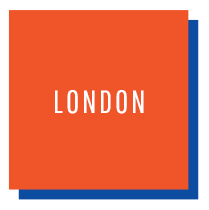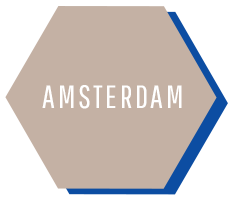GEOGRAPHIES OF THE URBAN SACRED
by Kim Knott
Take any square mile in Amsterdam, Berlin or London. Religion takes its place within an urban ecology and built environment dedicated to labour, trade and travel, dining and drinking, culture and media. Although formally open to the public, religious buildings house the private and mysterious practices of the faithful. A feature of the city’s façade and skyline, with signage announcing their presence and purpose, they signal other worlds beyond commerce and tourism. Not that they forbid such practices: many sell their services, books and artefacts, and participate actively in the heritage industry. But these are secondary to their principal purposes of witnessing to the divine and serving their religious communities, whether they live locally or further afield. It is not hard to imagine a time when such buildings were pre-eminent among landmarks, at the heart of their neighbourhoods, and grand in size and scale. Now they are often squeezed between monuments to other values and priorities, and dwarfed by high-rise structures of glass and steel.
How does the urban context affect and regulate the sacred? And how does religion in all its diversity shape the city, as well as people’s sense of its geography and place within the nation and wider world? These are spatial questions.[i] Together they suggest a dynamic relationship of mutual influence and interdependence, in which religions continue to contribute to the appearance and ambience of the city and how it is experienced by residents and visitors alike.
If you explore a square mile to the south of the Thames, in Southwark – the neighbourhood at the centre of our London research project – you will encounter Anglican and Catholic churches, schools and diocesan offices, the Metropolitan Tabernacle (a large Reformed Baptist church), vibrant churches like Crossways (with worshippers from Ghana, South Africa, Zimbabwe, Jamaica, Brazil, Korea, and Eastern Europe), two mosques serving Muslims of diverse ethnic groups, a Tibetan Buddhist temple, and Crossbones burial ground, now a focus for new rituals. Many of these places were purpose built for worship by their congregations, with some being shared or rented out. Other groups make do by recycling existing buildings. One new Christian church meets every Sunday in a hotel. The Buddhists are in an ex-public library. Local Bangladeshi Muslims, who first gathered for prayer in a shop basement, later acquired land for development and went on to build the Baitul Aziz Islamic Cultural Centre.
These places of praise, prayer and meditation are variously linked together in ecumenical and interfaith networks which manifest spatially in local meetings, processions and joint events. There is mutual recognition, but equally some wariness and differences of opinion. Some, like Southwark’s Nigerian Muslims and Korean Christians, have transnational connections in and beyond the UK. They represent some of the city’s more recent migrants, but they are not alone in having wider links. Religious Londoners are connected through diasporic relationships – to family back home and in other locations – but also through global denominational and sectarian movements, such as the Redeemed Christian Church of God, Islam’s Tablighi Jama’at, and the Kagyu Tibetan Buddhist lineage.[ii]
It is impossible to study urban space without also engaging with time and history, whether the focus is the contemporary built environment or the way the city is imagined, remembered or creatively reworked by inhabitants, writers or artists. The past contribution of religious institutions to architectural innovation, cultural patronage, trade and global interconnections continues to animate cities, and to influence how they are seen and represented today. Beneath the current footprint of London, the Roman development of the city from the first to the fourth century CE still makes itself known. In Southwark in 2014, when local Muslims excavated the land behind their mosque and had an archaeological survey conducted (in which some of them participated as volunteers), Roman inhumations and grave goods were discovered. These added to the emerging picture of Roman Southwark with its industry, commerce, domestic architecture, and Romano-Celtic temples.[iii]
Religious buildings old and new are a vital part of the heritage of European cities, central to tourism and to conserving the historic environment for the future. They are also important for the representation of the city in maps, walking guides and tours, novels and other cultural artefacts, including souvenirs. They are landmarks in well-known narratives of the city: in the histories of Amsterdam’s hidden churches, the Victorian horror stories of London’s East End, the ghost walks through the city’s Gothic underworld, the tragic personal stories of divided Cold War Berlin, and in public discourses of urban multiculturalism. A locality may be reimagined repeatedly in new guises, with religious buildings, people and practices either central or marginal, on the side of light and good, or dark and evil, confined to the past or an active part of the present and future.
The sacred may become more or less visible to readers or viewers as a place is reimagined, facing near erasure as the city is constituted as a tourist playground or leisure space for consumption and popular culture. This can be witnessed directly in the built environment: in Southwark, what was once a major landmark, its Anglican Cathedral, is now overshadowed by the Shard, one of London’s tallest skyscrapers. From the Shard’s upper floors, nearby churches, mosques and other religious buildings can be seen from above in miniature, but then so too can the city’s railway stations, museums, offices and public spaces. They are all dwarfed by this monument to capitalism.
The sacred geography of the city adapts as the values and priorities of both city and nation change. Today, the sacred – in secular as well as religious guises – appears in unexpected, temporary sites.[iv] Key moments of national significance are recalled in a sea of red poppies at the Tower of London, commemorating the outbreak of World War I, in the anniversary of the fall of the Berlin Wall, with its display of illuminated balloons, or in public demonstrations of grief and remembrance following terrorist incidents. The secular celebration of national values – of diversity, equality, fraternity – takes shape and form in European cities in multicultural events and festivals. London’s Trafalgar Square – symbol of Empire and ‘must-see destination’ for tourists – is multiculturally transformed throughout the year to mark the festivals of Britain’s major communities. Publicly badged as ‘cultural’ rather than ‘religious’, the festivals typically include Chinese New Year, Easter, Vaisakhi, the feast of St George, Gay Pride, Eid, Diwali, Chanukah and Christmas.
In these events, religious and other identities are outwardly performed. Different communities are invited onto the streets of central London to display their cultures. But they don’t always wait to be asked. People of diverse religions and none (the atheist Sunday Assembly, for example) make themselves seen and heard, whether through public meetings, vigils, processions or demonstrations. They inhabit public places and temporarily transform them to reflect their own beliefs and values. But they are also subject to urban regulatory regimes, to local laws on zoning, planning, registration, soliciting for donations and so on. Prohibitions and permissions shape the material and practical expression of the sacred in the city, with newcomers in particular often finding themselves constrained by established relations of power and dominant discourses and practices.[v]
Religious organisations respond to the surrounding urban geography in differing ways. Some assert themselves and compete by planning ‘show temples’ or ‘mega mosques’ which are locally contested and often negatively received in mainstream and social media.[vi] Others turn inwards and build boundaries to protect the devout from perceived negative influences. A third approach is engagement. For many years Southwark Cathedral acknowledged its relationship with its secular neighbours by allowing local workers to eat take-away lunches bought in Borough Market within its graveyard. The door was always open to invite curious passers-by across the threshold.
The impact works both ways. New sacred forces shape the urban environment as well as being shaped by it. Southwark’s Redcross Way might have remained a development site for London Underground had it not been for the rediscovery of its medieval paupers’ graveyard. A place made sacred by rituals for the ‘outcast dead’, and by vigils at its decorated gate and shrine, Crossbones has now become a local landmark and community garden.
[i] Knott, Kim (2009). ‘From locality to location and back again: A spatial journey in the study of religion’. Religion. 39(2): 154-60.
[ii] Rogers, Andrew (2013). Being Built Together: A Story of New Black Majority Churches in the London Borough of Southwark. London: Being Built Together; Garnett, Jane and Alana Harris, eds (2013). Rescripting Religion in the City: Migration and Religious Identity in the Modern Metropolis. Farnham: Ashgate.
[iii] Cowan, Carrie, Seeley, Fiona, Wardle, Angela, Westman, Andrew and Lucy Wheeler (2009). Roman Southwark Settlement and Economy. London: Museum of London Archaeology.
[iv] Knott, Kim (2013). ‘The secular sacred: in-between or both/and?’ In A. Day, G. Vincett and C. Cotter, eds, Social Identities between the Sacred and the Secular, 145-160. Farnham: Ashgate.
[v] Vásquez, Manuel and Kim Knott (2014). ‘Three dimensions of religious place-making in diaspora’. Global Networks. 14(3): 326–347.
[vi] Verkaaik, Oskar, ed. (2013). Religious Architecture: Anthropological Perspectives. Amsterdam: Amsterdam University Press.


